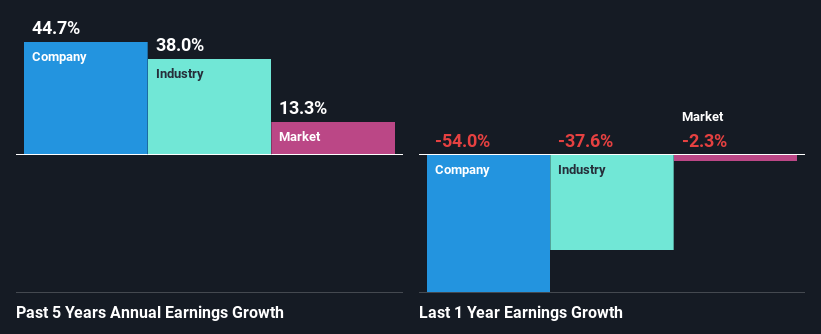Could The Market Be Wrong About Northern Oil and Gas, Inc. (NYSE:NOG) Given Its Attractive Financial Prospects?
It is hard to get excited after looking at Northern Oil and Gas' (NYSE:NOG) recent performance, when its stock has declined 7.1% over the past month. However, stock prices are usually driven by a company’s financial performance over the long term, which in this case looks quite promising. Particularly, we will be paying attention to Northern Oil and Gas' ROE today.
Return on Equity or ROE is a test of how effectively a company is growing its value and managing investors’ money. In other words, it is a profitability ratio which measures the rate of return on the capital provided by the company's shareholders.
View our latest analysis for Northern Oil and Gas
How To Calculate Return On Equity?
Return on equity can be calculated by using the formula:
Return on Equity = Net Profit (from continuing operations) ÷ Shareholders' Equity
So, based on the above formula, the ROE for Northern Oil and Gas is:
30% = US$594m ÷ US$2.0b (Based on the trailing twelve months to March 2024).
The 'return' is the yearly profit. One way to conceptualize this is that for each $1 of shareholders' capital it has, the company made $0.30 in profit.
What Is The Relationship Between ROE And Earnings Growth?
Thus far, we have learned that ROE measures how efficiently a company is generating its profits. Based on how much of its profits the company chooses to reinvest or "retain", we are then able to evaluate a company's future ability to generate profits. Assuming everything else remains unchanged, the higher the ROE and profit retention, the higher the growth rate of a company compared to companies that don't necessarily bear these characteristics.
Northern Oil and Gas' Earnings Growth And 30% ROE
To begin with, Northern Oil and Gas has a pretty high ROE which is interesting. Secondly, even when compared to the industry average of 18% the company's ROE is quite impressive. Under the circumstances, Northern Oil and Gas' considerable five year net income growth of 45% was to be expected.
Next, on comparing Northern Oil and Gas' net income growth with the industry, we found that the company's reported growth is similar to the industry average growth rate of 38% over the last few years.
Earnings growth is a huge factor in stock valuation. The investor should try to establish if the expected growth or decline in earnings, whichever the case may be, is priced in. By doing so, they will have an idea if the stock is headed into clear blue waters or if swampy waters await. What is NOG worth today? The intrinsic value infographic in our free research report helps visualize whether NOG is currently mispriced by the market.
Is Northern Oil and Gas Making Efficient Use Of Its Profits?
Northern Oil and Gas' three-year median payout ratio to shareholders is 7.7%, which is quite low. This implies that the company is retaining 92% of its profits. This suggests that the management is reinvesting most of the profits to grow the business as evidenced by the growth seen by the company.
Besides, Northern Oil and Gas has been paying dividends over a period of three years. This shows that the company is committed to sharing profits with its shareholders. Looking at the current analyst consensus data, we can see that the company's future payout ratio is expected to rise to 34% over the next three years. Therefore, the expected rise in the payout ratio explains why the company's ROE is expected to decline to 19% over the same period.
Conclusion
On the whole, we feel that Northern Oil and Gas' performance has been quite good. Particularly, we like that the company is reinvesting heavily into its business, and at a high rate of return. Unsurprisingly, this has led to an impressive earnings growth. Having said that, on studying current analyst estimates, we were concerned to see that while the company has grown its earnings in the past, analysts expect its earnings to shrink in the future. Are these analysts expectations based on the broad expectations for the industry, or on the company's fundamentals? Click here to be taken to our analyst's forecasts page for the company.
Have feedback on this article? Concerned about the content? Get in touch with us directly. Alternatively, email editorial-team (at) simplywallst.com.
This article by Simply Wall St is general in nature. We provide commentary based on historical data and analyst forecasts only using an unbiased methodology and our articles are not intended to be financial advice. It does not constitute a recommendation to buy or sell any stock, and does not take account of your objectives, or your financial situation. We aim to bring you long-term focused analysis driven by fundamental data. Note that our analysis may not factor in the latest price-sensitive company announcements or qualitative material. Simply Wall St has no position in any stocks mentioned.
Have feedback on this article? Concerned about the content? Get in touch with us directly. Alternatively, email editorial-team@simplywallst.com

 Yahoo Finance
Yahoo Finance 
